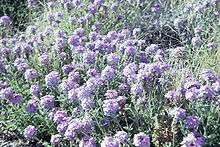Abronia villosa
Abronia villosa is a species of sand-verbena known by the common names desert sand-verbena[1] and chaparral sand-verbena. It is in the four o'clock plant family (Nyctaginaceae). It is native to sandy areas in the deserts of the southwestern United States and northern Mexico, associated with creosote-bush and coastal-sage scrub habitats.[2]
| Abronia villosa | |
|---|---|
 | |
| Scientific classification | |
| Kingdom: | Plantae |
| Clade: | Tracheophytes |
| Clade: | Angiosperms |
| Clade: | Eudicots |
| Order: | Caryophyllales |
| Family: | Nyctaginaceae |
| Genus: | Abronia |
| Species: | A. villosa |
| Binomial name | |
| Abronia villosa S.Wats., 1873 | |
Description
Abronia villosa is a short, hairy annual wildflower[2] which grows in creeping prostrate masses along the ground. It has oval-shaped dull green leaves and many peduncles bearing rounded inflorescences of bright magenta or purplish-pink flowers. It grows in the sand of the deserts and coastlines. It has a very sweet fragrance, and is also very sticky. They usually grow between February and May.
Chemistry
The rotenoids abronione and boeravinone C, and the terpenoid lupeol can be found in A. villosa.[3]
References
- USDA Plants Profile of Abronia villosa
- Jepson Manual Treatment — Abronia villosa
- Starks, CM; Williams, RB; Norman, VL; Lawrence, JA; Goering, MG; O'Neil-Johnson, M; Hu, JF; Rice, SM; Eldridge, GR (2011). "Abronione, a rotenoid from the desert annual Abronia villosa". Phytochemistry Letters. 4 (2): 72–74. doi:10.1016/j.phytol.2010.08.004. PMC 3099468. PMID 21617767.
Further reading
- Drennan, P.M. (May 2008). "Sand verbenas (Abronia spp., Nyctaginaceae) germinate in response to ethylene". Journal of Arid Environments. 72 (5): 847–852. doi:10.1016/j.jaridenv.2007.11.002.
External links
| Wikimedia Commons has media related to Abronia villosa. |